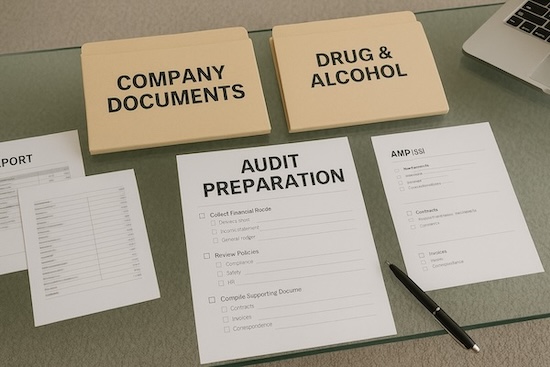New Entrant Safety Audit Preparation Services
Professional new entrant safety audit preparation for new carriers. Get expert help passing your mandatory 18-month educational safety audit. While designed to help new carriers learn compliance requirements, acute violations can result in immediate shutdown of your operation.
Got your new entrant audit notice and need help now?
This is a learning opportunity that can shut you down. We'll prepare your documentation, coach your team, and ensure you pass with confidence.
New Entrant Safety Audit Preparation Requirements Checklist
Essential documentation and systems every new carrier must have in place to pass their FMCSA new entrant safety audit. Missing any of these can result in automatic failure.
Core Documentation Requirements
- Drug & Alcohol Testing Program: Written policy, random consortium enrollment, pre-employment testing procedures
- Driver Qualification Files: Complete DQ files per 49 CFR 391.51 for every driver
- Hours of Service Compliance: ELD implementation, driver training, supporting documents policy
Vehicle & Maintenance Requirements
- Vehicle Maintenance Program: DVIR procedures, preventive maintenance schedules, annual inspections
- Insurance Documentation: Required minimum coverage, MCS-90 endorsements, certificates of insurance
- Safety Management Systems: Written policies, training records, corrective action procedures
New Entrant Specific Requirements
- Clearinghouse Registration: Employer and driver accounts, annual query compliance
- Supervisor Training: Reasonable suspicion training certificates per 49 CFR 382.603
- Medical Certifications: Valid DOT physicals, medical examiner registry verification
Registration & Record Keeping
- CDL Verification: Valid commercial licenses, no disqualifications, proper endorsements
- Company Registration: Current MCS-150, operating authority, USDOT number documentation
- Record Retention System: Organized filing system, easy auditor access, complete documentation
Additional Support Services
Need help with any of these requirements? Our comprehensive compliance services cover everything from drug testing programs to complete DOT audit preparation.
New Entrant Safety Audits: Educational Opportunity with Real Consequences
Understanding the dual nature
New entrant safety audits are specifically designed as educational opportunities per FMCSA's New Entrant Safety Assurance Program. Unlike compliance reviews that assign safety ratings, these audits focus on helping new carriers understand regulatory requirements and establish proper safety management systems.
Educational benefits for new carriers
The educational aspects include:
- Furthermore, auditors provide guidance on proper recordkeeping
- Additionally, technical assistance on safety regulation compliance
- Moreover, help establishing basic safety management controls
- Consequently, no safety rating assigned (Satisfactory/Conditional/Unsatisfactory)
- Therefore, focus on building long-term compliance systems
However, this differs from standard DOT compliance reviews which assign safety ratings and focus on enforcement rather than education.
Educational Purpose
Per 49 CFR 385 Subpart D, new entrant audits are designed to:
- Provide technical assistance on FMCSR compliance
- Help establish safety management controls
- Gather safety data for ongoing monitoring
- Educate on proper record retention requirements
But the Consequences Are Very Real
⚠️ Critical Consequences
- Immediate shutdown for acute violations
- Operating authority revocation for inadequate documentation
- No conditional status - pass or face closure
- 45-60 day corrective action period if failed
- Complete restart required if authority revoked
Why carriers fail new entrant audits
Despite the educational nature, new entrant audits can end your business immediately. However, the most common reasons for failure include inadequate drug and alcohol programs, missing driver qualification files, and lack of basic safety management systems.
Critical differences from regular audits
Remember: This isn't like a regular compliance review where you might get a conditional rating and time to improve. In contrast, with new entrant audits, acute violations mean immediate out-of-service orders.
Additionally, visit the official FMCSA New Entrant audit site for current procedures and detailed requirements.
New Entrant Audit Timeline and Process
When your audit will happen
FMCSA schedules new entrant safety audits within specific timeframes based on your operation type. Additionally, understanding the timeline helps you prepare early and avoid last-minute scrambling.
Audit scheduling by carrier type
Audit scheduling:
- First, property carriers: Within 12 months of beginning operations
- Next, passenger carriers: Within 6 months of beginning operations
- Similarly, hazmat carriers: Within 6 months of beginning operations
- Finally, notification: Typically 10-30 days advance notice
Furthermore, the audit can be conducted on-site at your business location or off-site through document submission, depending on FMCSA's determination.
🗓️ New Entrant Timeline
- Day 0: Begin operations with new entrant status
- 6-12 months: Safety audit scheduling window
- 10-30 days: Advance notification from FMCSA
- Audit day: Pass or face immediate consequences
- 45-60 days: Corrective action period if failed
- 18 months: New entrant monitoring period ends
Automatic Failure Violations: Zero Tolerance Issues
Certain violations will automatically fail your new entrant audit with no exceptions. These acute violations require immediate corrective action and can result in operating authority revocation.
Drug & Alcohol Violations
- No alcohol and/or drug testing program
- No random testing program
- Using a driver who refused a test
- Using a driver with BAC 0.04 or greater
- Using a driver who failed follow-up procedures
- Missing Clearinghouse queries
Driver Violations
- Using a driver without valid CDL
- Using a disqualified driver
- Using driver with revoked/suspended CDL
- Using medically unqualified driver
- Missing driver qualification files per 391.51
CDL Requirements
All drivers must maintain valid commercial licenses with proper endorsements and medical certifications.
Operational Violations
- Operating without required insurance
- No hours-of-service records
- Operating vehicle declared out-of-service
- Not performing OOS repairs from DVIRs
- Operating vehicle not annually inspected
Insurance & Documentation
Proper insurance coverage and systematic record keeping are essential for compliance.
Complete New Entrant Audit Preparation

Documentation we prepare for your audit
- First, drug & alcohol program: Complete testing program setup, random consortium enrollment, policy documentation, and Clearinghouse compliance
- Next, driver qualification files: Complete files per 49 CFR 391.51 including applications, MVRs, medical certificates, and road tests
- Additionally, hours of service compliance: ELD setup verification, log completion training, and supporting document procedures
- Furthermore, vehicle maintenance program: DVIR procedures, preventive maintenance schedules, and annual inspection compliance
- Moreover, insurance documentation: Required coverage verification and MCS-90 endorsements
- Finally, safety management systems: Written policies, training documentation, and corrective action procedures
Therefore, we focus on education while ensuring compliance. Our goal is to help you understand the requirements while building systems that will keep you compliant long after your new entrant period ends.
Consequently, nationwide service: We provide new entrant safety audit preparation services across all 50 states, with specialized knowledge of state-specific requirements. As a result, whether you're based in California, Texas, Florida, or anywhere else, our team understands both federal FMCSA requirements and local compliance nuances.
LBC Fleet New Entrant Audit Process

Systematic approach for new carriers
- First, new entrant assessment: Review your current systems and identify gaps specific to new entrant requirements
- Next, education and training: Explain regulatory requirements and help you understand compliance obligations
- Then, system development: Build basic safety management controls from the ground up
- Additionally, documentation assembly: Create audit-ready files organized for easy auditor review
- Furthermore, mock audit preparation: Practice sessions to prepare you for auditor questions and review process
- Finally, ongoing support: Continued monitoring throughout your 18-month new entrant period
Moreover, we treat this as the learning opportunity it's designed to be while ensuring you avoid the serious consequences of failure.
Ready for Your New Entrant Safety Audit
We'll help you understand the requirements, build compliant systems, and pass your audit so you can focus on growing your business.
New Entrant Safety Audit FAQ
What makes new entrant audits different from regular compliance reviews
New entrant audits are educational in purpose but critical in consequences. Per the FMCSA New Entrant Program, these audits help new carriers understand compliance requirements and establish proper systems.
Key differences:
- No safety rating assigned (Satisfactory/Conditional/Unsatisfactory)
- Focus on education and system development
- Auditors provide guidance on proper recordkeeping
- Technical assistance on regulatory compliance
But consequences remain severe: Acute violations trigger immediate out-of-service orders, and inadequate documentation can lead to operating authority revocation. There's no "conditional" status - you either demonstrate adequate systems or face shutdown.
When will my new entrant audit be scheduled
New entrant audit timing depends on your operation type:
- Property carriers: Within 12 months of beginning operations
- Passenger carriers: Within 6 months of beginning operations
- Hazmat carriers: Within 6 months of beginning operations
You'll typically receive 10-30 days advance notice. The audit can be conducted on-site or off-site depending on FMCSA's determination.
What violations automatically fail a new entrant audit
Automatic failure violations include:
- Drug/Alcohol: No testing program, no random program, using drivers who refused tests
- Drivers: Using drivers without valid CDL, disqualified drivers, medically unqualified drivers
- Operations: No insurance, no HOS records, operating out-of-service vehicles
Visit the official FMCSA site for the complete list of automatic failure violations.
Do I need Clearinghouse compliance for new entrant audits
Yes. All employers with CDL drivers must be registered in the FMCSA Drug & Alcohol Clearinghouse and conduct required queries. Failure to comply with Clearinghouse requirements is an automatic failure violation for new entrant audits.
What happens if I fail my new entrant audit
If you fail your new entrant audit, you'll have 45-60 days to implement a corrective action plan addressing all deficiencies. If you don't successfully correct the issues within this timeframe, FMCSA will revoke your operating authority and place you out of service.
Unlike regular compliance reviews, there's no "conditional" rating - you either pass or face potential shutdown.
Can you help with corrective action if I already failed
Yes. If you've already failed your new entrant audit, we can help develop and implement a comprehensive corrective action plan within the required timeframe. We'll address each violation with specific procedures and documentation to demonstrate adequate safety management controls.
Our Safety Rating Upgrade services include corrective action plan development, violation remediation, and ongoing compliance monitoring to ensure successful resolution.
How long does new entrant status last
New entrant status lasts 18 months from when you receive your USDOT number. During this period, FMCSA closely monitors your safety performance through roadside inspections and other data. After successfully completing the new entrant period, you'll receive permanent operating authority.
How much does new entrant safety audit preparation cost
Our new entrant safety audit preparation services are billed at $150 per hour. Most new entrant audits require approximately 5 hours of preparation work, making the typical total cost around $750.
This includes complete file preparation, system setup guidance, mock audit sessions, and coaching to help you understand the requirements and pass your audit successfully.
What states do you serve for new entrant audit preparation
We provide new entrant audit preparation services nationwide across all 50 states. Our team has experience with state-specific requirements and variations in how different FMCSA field offices conduct new entrant audits.
Popular service areas include California, Texas, Florida, Illinois, Pennsylvania, Ohio, Georgia, North Carolina, Michigan, and Virginia. We also serve carriers in smaller markets and rural areas through our remote preparation services.
Do new entrant audits result in safety ratings
No. New entrant safety audits do not result in safety ratings (Satisfactory/Conditional/Unsatisfactory). The purpose is educational - to help you establish proper compliance systems. However, this doesn't reduce the serious consequences of failure, which can include immediate shutdown.
After your 18-month new entrant period, you may be subject to regular DOT compliance reviews that do assign safety ratings.